Key takeaways:
- Post-Impressionism focuses on personal expression, emotional depth, and symbolism, moving beyond the techniques of Impressionism.
- Art analysis reveals layers of meaning in artworks, linking the artist’s choices with their emotional states and historical contexts.
- Techniques for analyzing art include examining color, brushstroke, composition, and engaging with the artist’s background to enhance understanding.
- Visiting art galleries benefits from taking time with each piece, exploring the space, and engaging with staff for deeper insights.
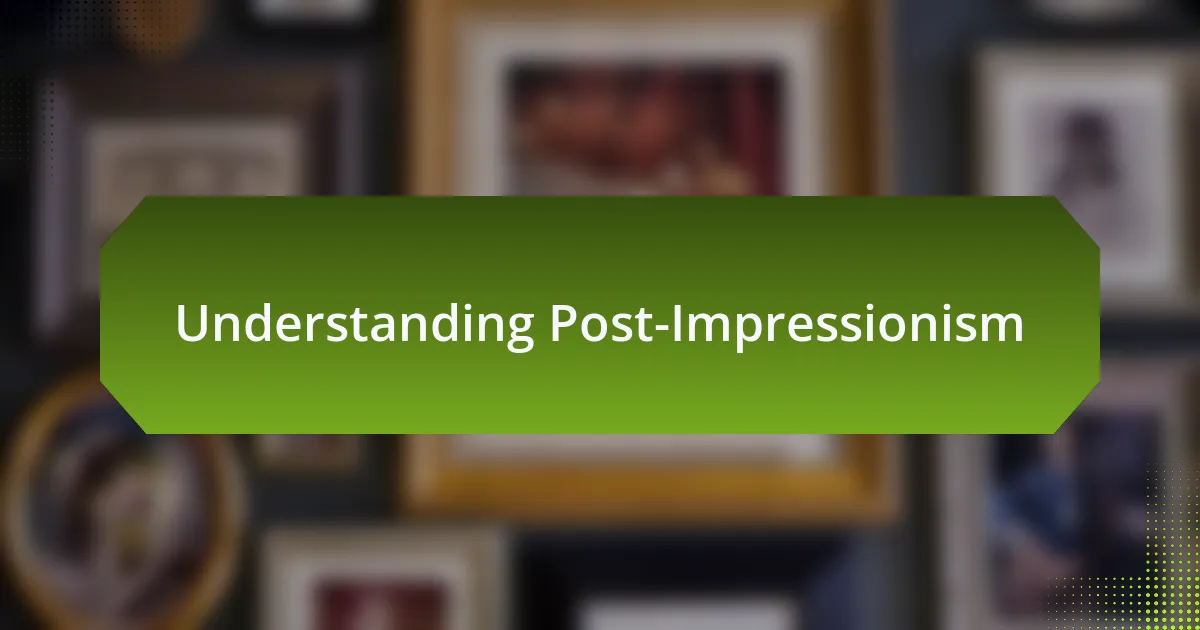
Understanding Post-Impressionism
Post-Impressionism emerged as a vibrant movement, departing from the strict techniques of Impressionism to explore emotional depth and symbolism. I remember the first time I stood before Van Gogh’s “Starry Night.” The swirling skies evoked a sense of chaotic beauty, prompting me to wonder: how can a painting speak so profoundly? That’s the essence of Post-Impressionism—transforming personal experience into bold, visible form.
Artists like Gauguin and Cézanne challenged traditional representation, emphasizing the artist’s subjective perspective over mere reality. I’ve often found myself captivated by Gauguin’s use of color, which seems to breathe life into scenes reminiscent of dreams. Isn’t it fascinating how he went to Tahiti, searching for a paradise untouched by modernity? His quest reflects a deep yearning for authenticity that resonates even today.
In this movement, brushwork became a tool for conveying emotion rather than just depicting an image. When I analyze a painting from this era, like Cézanne’s landscapes, I feel the innate tension between observation and interpretation. It makes me ask: what did the artist feel that led to such distinct choices in color and form? Understanding Post-Impressionism is not just about looking at art; it’s about connecting with the artist’s journey and the emotions that inspired their work.
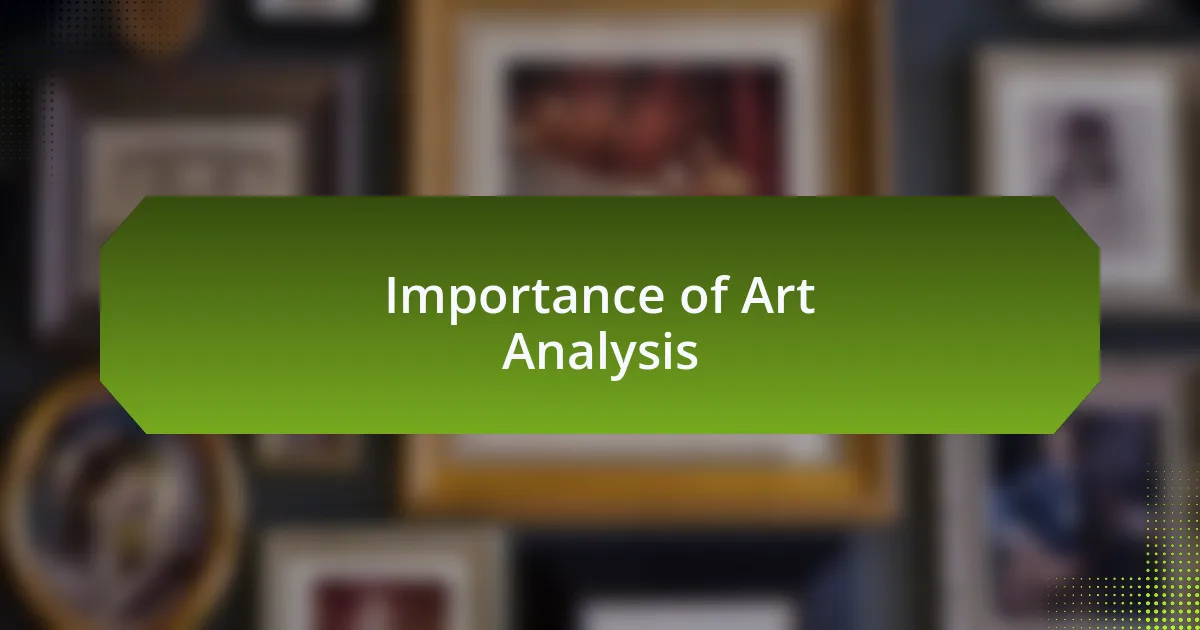
Importance of Art Analysis
Art analysis plays a crucial role in unlocking the layers hidden within artworks. I recall attending a gallery talk where the curator dissected a Cezanne painting, revealing how his brushstrokes illustrated not just the landscape but also his emotional state at the time. It dawned on me that every decision an artist makes—color choice, texture, form—serves as a dialogue, inviting us to engage and interpret.
Furthermore, diving into art analysis can transform our perception of beauty and meaning. On one occasion, while studying Van Gogh’s “The Night Café,” I found myself reflecting on the intense colors and stark contrasts. I wondered: what feelings did he want to evoke in us? By unraveling the context and techniques used, I felt a deeper connection, almost as if I could sense his passion and struggle seeping through the canvas.
Each analysis can reveal insights not only about the artwork itself but also about the cultural and historical backdrop that shaped the artist’s vision. I remember once discussing Gauguin’s use of exotic themes while sipping coffee with fellow art enthusiasts. Our conversations illuminated how his experiences influenced his work, sparking my curiosity about the narratives that color the tapestry of art history. Isn’t it enriching to think that every stroke might tell a story that resonates with our own experiences?

Key Characteristics of Post-Impressionism
Post-Impressionism is distinguished by its emphasis on individual expression and emotional resonance. I vividly recall my first encounter with a Van Gogh piece, specifically “Starry Night.” The swirling skies and bold colors struck me as more than just a night scene; they felt like an echo of the artist’s inner turmoil and deep passion. Isn’t it fascinating how a simple landscape can convey such complexity?
Another hallmark of Post-Impressionism is the experimentation with color and form. Take Cezanne, for example; his approach to blending colors and simplifying shapes reshaped my understanding of perspective in art. I distinctly remember viewing one of his still lifes up close and realizing that each brushstroke seemed deliberate, almost as if he was redefining reality on his own terms. Can you see how these techniques push beyond the boundaries set by Impressionism?
Moreover, the movement often explores symbolic meaning and personal narratives. I once attended an exhibit featuring Gauguin, where his bold use of color not only highlighted the beauty of the Tahitian landscape but also reflected his search for identity and belonging. I found myself pondering: how much of our own experiences influences our perception of art? The way these artists intertwined their personal stories with their works invites us to engage with them profoundly, blurring the lines between observer and participant in their emotional journey.
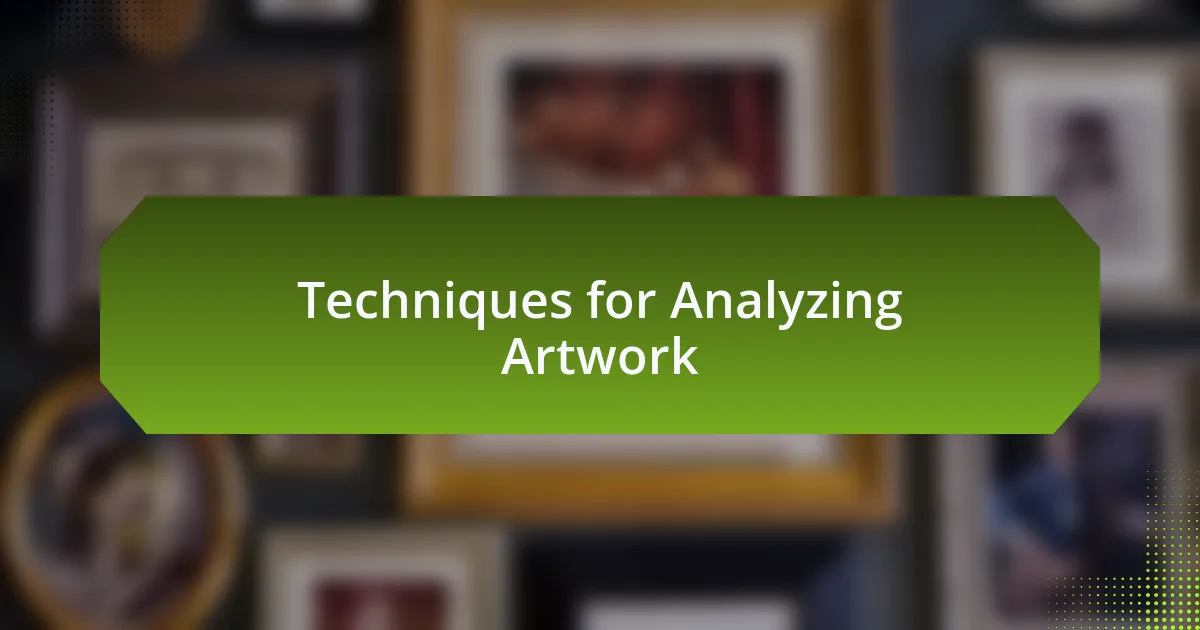
Techniques for Analyzing Artwork
When analyzing artwork, one effective technique is to focus on the use of color and brushstroke. I remember standing in front of a Seurat painting and feeling overwhelmed by the tiny dots of color. Each dot seemed to play a crucial role in the overall composition and my interpretation. How much does color choice actually influence our emotional response? It’s remarkable how subtle shifts can evoke different feelings, making color a vital element in understanding a piece.
Another approach involves examining the composition and layout of the artwork. I once visited a gallery where I was captivated by a Cezanne piece. The way he arranged objects in the still life created a sense of dynamic balance that challenged my initial perceptions of stillness. Have you ever noticed how the positioning of elements can tell a story? This technique not only enhances visual appeal but also invites the viewer to explore the narrative behind the arrangement.
Finally, engaging with the historical context can dramatically enhance your analysis. During a recent art history class, we explored Van Gogh’s works alongside the backdrop of his life struggles. Reflecting on his mental health and societal influences gave deeper meaning to his bold colors and swirling forms. How does understanding an artist’s background change the way we appreciate their work? I find that this connection makes each piece resonate more profoundly, bridging the gap between the artist’s intention and the viewer’s experience.

Resources for Studying Artists
Resources for studying artists can be incredibly diverse and enriching. I often delve into online databases like JSTOR or Google Scholar, where I’ve unearthed academic articles that offer deep dives into artists’ techniques and influences. Have you considered how scholarly work can elevate our understanding of art? It replaces assumptions with informed critiques, enriching the dialogue around specific pieces.
Another invaluable resource is attending local art lectures or workshops. A few months ago, I participated in a workshop focusing on post-impressionism, where the facilitator passionately discussed lesser-known artists alongside the giants like Monet or Van Gogh. It felt electric to sit among fellow art enthusiasts, sharing insights and discovering new perspectives. How often do we find ourselves in spaces that ignite our passion for learning? Such environments foster connections that go beyond the surface of artwork.
Finally, I highly recommend seeking out artist biographies and documentaries. I recall watching a documentary about Gauguin that transformed my understanding of his adventure-filled life and bold choices. Seeing his world rendered on screen brought a personal touch to my study. Have you ever found that a visual narrative helps solidify the knowledge you’ve gathered? It’s fascinating how these resources can illuminate not just the art, but the soul of the creator behind each canvas, inviting a deeper appreciation for their journey.
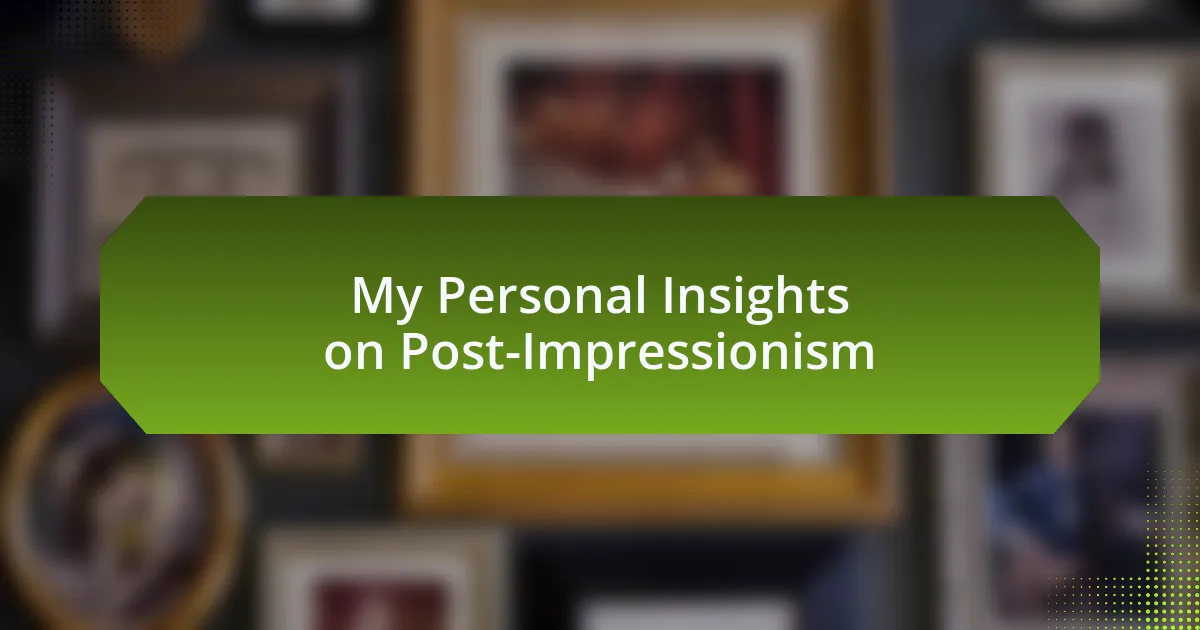
My Personal Insights on Post-Impressionism
When I think about Post-Impressionism, I often find myself drawn to the emotional depth it encapsulates. I remember standing before a Van Gogh painting, feeling a rush of emotions as the vivid colors danced on the canvas. It struck me how these artists moved beyond simply capturing reality; they expressed their inner worlds. Have you ever felt a painting reach out to you in such a profound way?
One afternoon, I stumbled upon a lesser-known work by Paul Cézanne in a small gallery. As I gazed at the brush strokes, I could sense his struggle with perception and representation. That experience reinforced my belief that Post-Impressionism is more than an art movement; it’s a raw portrayal of the artist’s psyche. In what ways do you think an artist’s emotional state shapes the artwork they create?
Reflecting on the techniques used in this movement, I find that the interplay of color and form creates a unique language that speaks to the viewer. I recall a late evening spent analyzing works by Georges Seurat, particularly how his pointillism invites viewers to piece together their own experiences. Have you experienced how intimately engaging with technique can alter your interpretation? It’s as if the dots form a bridge between the artist’s intent and our individual perceptions.
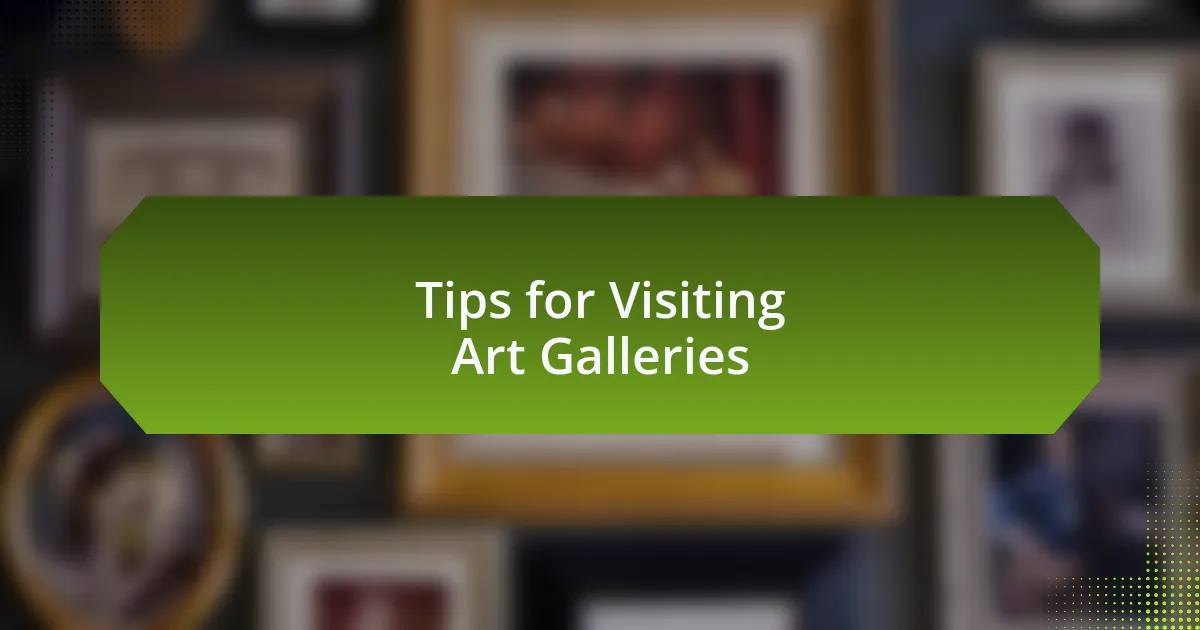
Tips for Visiting Art Galleries
When I visit an art gallery, I always take my time with each piece. I vividly remember standing in front of a large canvas and letting myself absorb every detail. Have you ever noticed how the atmosphere changes with the number of visitors? A quieter moment can make the colors and textures truly resonate.
A helpful tip is to start with a general walk-through before diving deep into your favorites. On one occasion, I found myself rushing to my top picks only to realize I had overlooked some hidden gems. It’s fascinating how a casual stroll can lead to unexpected connections and insights into the artist’s intentions, don’t you think?
Lastly, don’t hesitate to ask the staff questions. I recall chatting with a curator who shared stories behind certain artworks that enriched my understanding of the pieces significantly. Engaging with those who are passionate about art can unlock new perspectives and enhance your art gallery experience immensely.